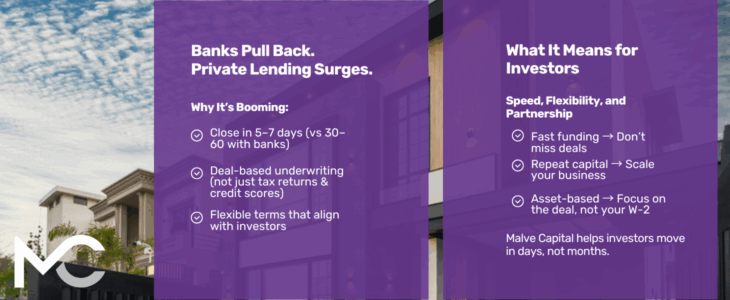In a world where access to capital defines your pace and potential, the rules of the game are changing fast. Over the last 18 months, banks have pulled back—tightening credit requirements, slashing approvals, and increasing the scrutiny on every single borrower.
But one sector hasn’t flinched: private lending. In fact, it’s accelerating.
If you’re a real estate investor trying to navigate high interest rates, longer approval times, and increased borrower friction, understanding the private lending boom isn’t just interesting—it’s essential. This shift isn’t temporary. It’s systemic. And it’s creating once-in-a-cycle opportunities for investors who know how to leverage it.
What’s Behind the Bank Pullback?
The Federal Reserve’s rate hikes between 2022 and 2024 put serious pressure on banks—especially regional and local institutions. With rising cost of capital, increased regulatory oversight, and reduced risk appetite, many have moved to protect their balance sheets instead of funding aggressive growth.
The result? Banks are:
- Requiring near-perfect credit
- Asking for excessive documentation
- Slashing loan-to-value (LTV) ratios
- Prioritizing only vanilla, low-risk borrowers
Even Freddie Mac acknowledged that small-scale investors are facing increasing hurdles from traditional financing channels. That leaves the door wide open for non-bank lenders to fill the void—and they’re doing it with speed.
Why Private Lending Is Booming
Private lenders, also known as hard money or direct lenders, operate differently. They’re not constrained by Basel III rules or FDIC thresholds. They move based on the quality of the deal—not just the borrower.
Here’s what’s fueling the surge:
- Speed to close: Investors can get funded in as little as 5–7 days, versus 30–60 days with banks.
- Asset-based underwriting: The deal’s value, not your tax return, drives approval.
- Flexible terms: Adjustable LTVs, interest-only payments, short-term structures.
- Investor-aligned thinking: Many private lenders are former operators themselves.
Sites like Mortgage News Daily have started covering this pivot more seriously, noting how direct lenders are now capturing meaningful market share in real estate finance.
Who’s Benefiting Most?
The biggest winners in this environment are active real estate investors—especially those doing fix-and-flip, BRRRR, and ground-up development projects. These operators typically don’t check all the traditional boxes: perfect credit, W-2 income, long-standing banking relationships.
But they do have:
- A solid deal
- A clear exit strategy
- A renovation plan
- Local market experience
Private lenders recognize that. And in many cases, they’re providing repeat capital to the same borrowers—reducing friction and accelerating the path to scale.
How This Impacts Strategy in 2025
We’re not going back to 2021. Capital isn’t cheap anymore. But access still matters—and that’s where private lending shines.
Smart investors are adjusting their approach in several key ways:
- Underwriting for speed: Structuring deals that can be underwritten in 24–48 hours.
- Building lender relationships: Treating lenders like strategic partners, not one-off vendors.
- Layering capital: Mixing private lending with equity, preferred returns, or mezzanine debt to complete the stack.
- Planning exits conservatively: Ensuring multiple viable paths: flip, refinance, or hold.
If you’ve only used banks until now, this shift might feel uncomfortable. But with more private lenders entering the space, competition is driving better borrower experiences—and often, better terms.
Risks to Consider
Private lending is faster, but it’s not without its costs. Interest rates are higher (typically 9–12% in 2025), and fees may be front-loaded. Investors need to account for this in their pro forma and confirm the numbers still pencil out.
Due diligence matters. Make sure your lender is licensed, experienced, and transparent about draws, fees, and timelines.
What It Means for You
If you’ve felt stalled by tight bank underwriting or missed a deal due to slow capital, this moment is your inflection point. Private lenders aren’t a last resort—they’re becoming the first call for serious operators who value speed, flexibility, and direct partnership.
At Malve Capital, we’re seeing record demand from investors looking to move fast on real estate in high-growth regions like Texas, Florida, and Georgia. The question isn’t whether private lending works—it’s whether you’re ready to use it to your advantage.
Whether you’re flipping your first house or financing a ground-up multifamily, understanding how to work with private lenders in 2025 could be the most powerful unlock in your business this year.
Ready to find out how it works? Talk to a Malve Capital lending expert and learn how you can close in days—not months.

